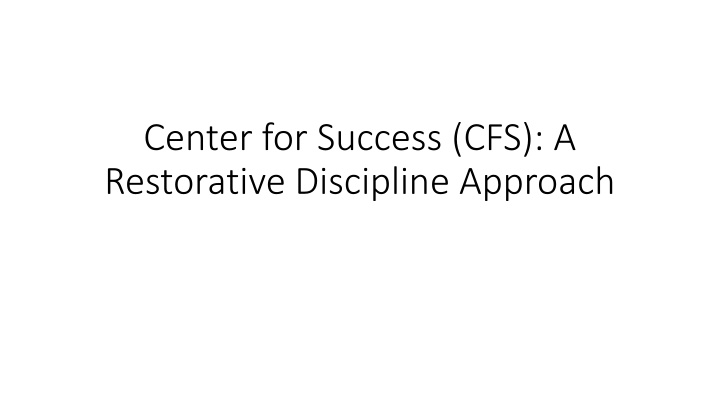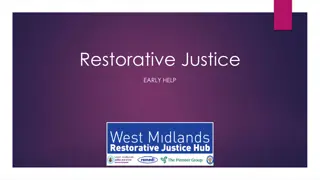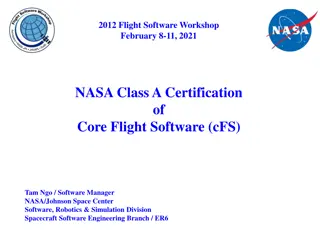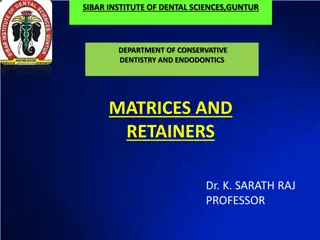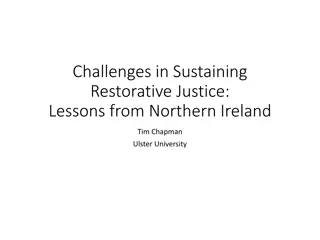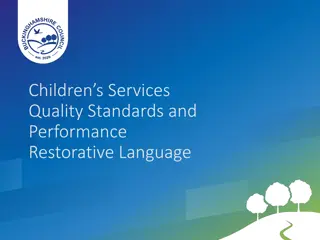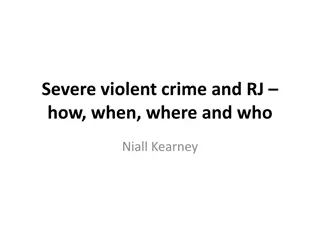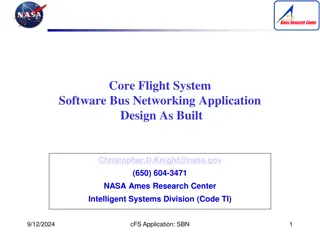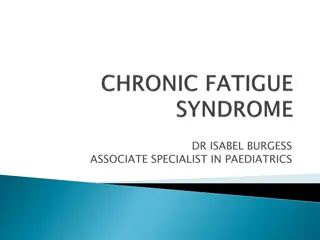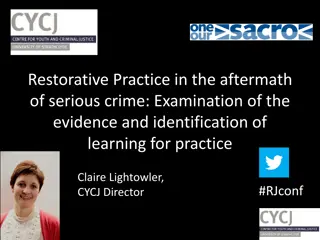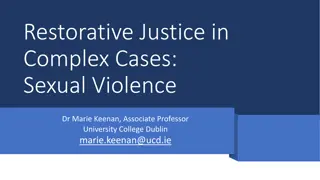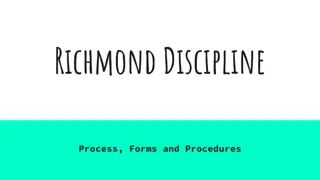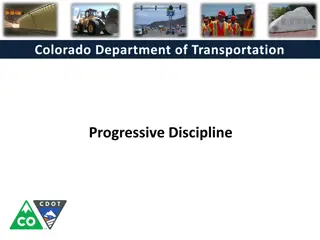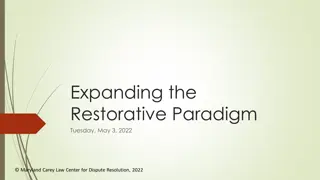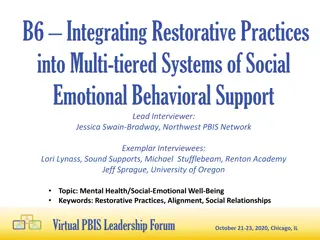Center for Success (CFS): Restorative Discipline Approach
A paradigm shift in student discipline, Restorative Discipline offers an alternative to exclusionary practices. It focuses on understanding harm, accountability, and rebuilding relationships for a positive school culture.
Download Presentation

Please find below an Image/Link to download the presentation.
The content on the website is provided AS IS for your information and personal use only. It may not be sold, licensed, or shared on other websites without obtaining consent from the author.If you encounter any issues during the download, it is possible that the publisher has removed the file from their server.
You are allowed to download the files provided on this website for personal or commercial use, subject to the condition that they are used lawfully. All files are the property of their respective owners.
The content on the website is provided AS IS for your information and personal use only. It may not be sold, licensed, or shared on other websites without obtaining consent from the author.
E N D
Presentation Transcript
Center for Success (CFS): A Restorative Discipline Approach
Expectations for our Students Kindness Start A Chain Reaction is a priority. Academic Integrity is a priority! Student Engagement is a priority. Social/Electronic Media & Personal Representation is a priority.
Center For Success (CFS) At-Risk Conferences Mediation Students in Crisis Discipline CFS
What is Restorative Discipline? A paradigm shift in how we think about student discipline. An offshoot of Restorative Justice in the criminal justice system. An alternative to exclusionary discipline. Not a quick or easy fix. The George Ranch way!!!
Paradigm Shift: From This Traditional Discipline In the traditional system of student discipline we ask: What rule was broken? Who did it? What is the punishment? Restorative Discipline Restorative Discipline asks: What happened? Who has been affected? What are we going to do to make things right?
Paradigm Shift: What Does Accountability Mean? Traditional Discipline Accountability means the student who broke the rule is punished. Restorative Discipline Accountability means the student who caused harm comes to understand the harm caused and has the duty to repair the damage to the relationship.
Paradigm Shift: Who Are We Focusing Our Attention On? Traditional Discipline We focus on the student who broke the rule, and often ignore those who have been harmed. Restorative Discipline We focus on all parties, and give voice to all parties the student who cause harm, the person harmed, and the school.
Paradigm Shift: What Are We Focused On? Traditional Discipline Traditional: We focus on equal enforcement of our rules. Consistency in how we respond to student misconduct. Restorative Discipline Restorative: We focus on the desired outcome for all parties the person harmed is heard from; the student who caused harm understands the harm done and takes responsibility for repairing the damage. The relationship is restored.
Paradigm Shift: Opportunities Traditional Discipline Traditional: The students who broke the rule has little opportunity to express remorse or make amends. Restorative Discipline Restorative: The student who caused harm has the opportunity to directly express remorse and directly make amends in short, to contribute to the restoration of the relationship.
Paradigm Shift: How We Learn Traditional Discipline Traditional: The student will learn better behavior from the punishment itself. That ll teach him! Restorative Discipline Restorative: The student who caused harm has the opportunity to directly express remorse and directly make amends in short, to contribute to the restoration of the relationship.
It Comes from the Criminal Justice System Restorative Justice is a set of principles and practices that are increasingly being used in the criminal justice system. Our traditional model of student discipline is based on the criminal justice system. The code of conduct is like the Penal Code. The DAEP is like a jail. We sentence kids for periods of time. So it makes sense that we would also model restorative practices.
An Alternative Restorative Discipline practices do not replace the use of traditional forms of student discipline. Suspension and DAEP still remain. Restorative Discipline offers an alternative way of dealing with misconduct when people are willing. And it offers hope that school climate will improve to the point that misconduct decreases.
Interventions Academic Integrity Agreement Behavior Agreement Electronic Media Agreement Extracurricular Behavior Expectations Student/Administrator Student/Teacher Student/Student Student/Parent/Administrator Conference/Mediation Anger Management Self-Esteem Group Counseling Documentation (Eduphoria) Behavior Management Plan Staffings Response to Intervention
Consequences 2 Hour (Tuesdays & Thursdays) 4 Hour (Saturday) Detention Extracurricular Suspension Out of School Suspension Suspension 20 Day Placement 45 Day Placement DAEP/ALC
No ISS Why??? Negative Connotation Cold Environment Limited instruction, if any Does not deter bad behavior Waste of teacher/administrator s time
Not a quick or Easy Fix Restorative Discipline is a radically different way of dealing with student discipline issues. It requires total buy-in from administration and teachers. It is time consuming. It requires teachers to relinquish some elements of control. Or the illusion of control????
Why Restorative Discipline? Why CFS? It s the George Ranch Way!!! Because traditional tools of student discipline are going away. Office of Civil Rights Because Restorative Discipline leads to the development of the ultimate career readiness Skillset. Teaches students how to properly handle conflict Because it gets us back to doing what educators were designed to do: Teach, Inspire and Build Community. Teachers are not having to stop instruction to write a discipline referral at the computer. Administrators, counselors and teachers have the opportunity to work with students to look at the whole child when a discipline issue occurs. Previous referrals; grades; absences, etc.
The Numbers There is a stark contrast in discipline data when compared to other schools in our area with a similar demographic makeup. 2010-2011 2011-2012 2012-2013 2013-2014 756 Students 1296 Students 1836 Students 2070 Students 45 234 178 210 Suspensions = 84 Days Suspensions = 334 Days Suspensions = 288 Days Suspensions = 329 Days 33 ALC Placements 50 ALC Placements 35 ALC Placements 48 ALC Placements
48 ALC Placements Grade Level Breakdown 20 9thGrade Placements 14 10thGrade Placements 7 11thGrade Placements 7 12thGrade Placements 17 Discretionary Placements 3 Failure to Follow Rules 4 Gang Activity/Writing 1 Non-Illegal Knife 1 Major Campus Disruption 7 Serious and Persistent Misbehavior 1 Threat to Student 31 Mandatory 3 Alcohol 1 Assault on a Student 27 Drugs
ALC Placement Demographics Gender 7 Female 41 Male Ethnicity 0 American Indian 2 Asian 9 African American 5 Hispanic 32 White
Classroom Discipline & 4200 Calls Teachers dial ext. 4200 if student(s) are disruptive to the point where it stops instruction in the classroom. A security guard or administrator will come to the classroom and remove the student. Teacher will have an opportunity to explain what occurred in the classroom to the security guard or administrator. Student is escorted to CFS. The student signs in and sits down to write their statement of what occurred. The student is seen by the administrator assigned to CFS for the day in a timely manner. Plan of action/consequences are assessed and communicated to all parties involved.
